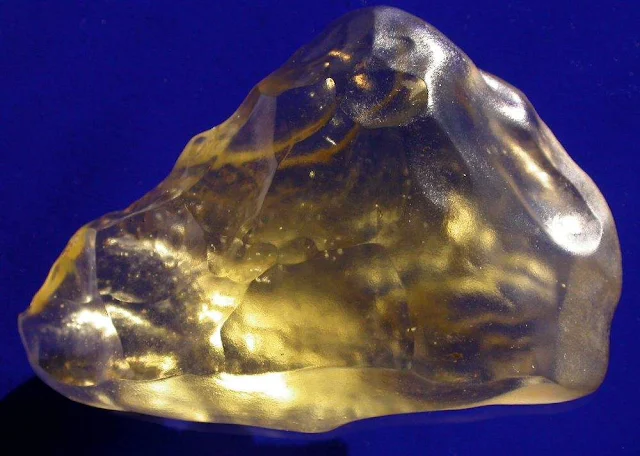Lonsdaleite Diamonds Formed by High Energy Event
Lonsdaleite also called hexagonal diamond in reference to the crystal structure, is an allotrope of carbon with a hexagonal lattice.
Lonsdaleite, also known as hexagonal diamond, is an allotrope of carbon, like diamond and graphite, with a hexagonal crystal structure. Unlike diamond, which has a cubic crystal structure, lonsdaleite's carbon atoms are arranged in a hexagonal lattice. This difference in crystal structure gives lonsdaleite some unique properties, such as a higher hardness and a lower density than diamond.
Lonsdaleite is extremely rare and is only found in trace amounts in some meteorites. It is formed when graphite, a common form of carbon found in meteorites, is subjected to the immense pressure and heat of a meteorite impact. The extreme conditions of the impact transform the graphite into a diamond-like structure, but with the hexagonal crystal lattice of graphite.
Lonsdaleite is named after Dame Kathleen Lonsdale, a British crystallographer who made significant contributions to the understanding of the structure of carbon allotropes. She was the first to propose the existence of lonsdaleite in 1962, although it was not until 1967 that it was first identified in a meteorite.
Lonsdaleite diamonds has been found around the Tunguska Event, Canyon Diablo (Barringer/Meteor Crater in Arizona), Popigai crater and other 'impact' craters or areas.
 |
| Lonsdaleite Diamonds Formed by High Energy Event? Lonsdaleite Diamonds Fulgurites Desert Glass |
Are diamonds and minerals formed by mega electrical discharges or events in and on the earths surface?
Comet/meteor impacts in deserts are said to create desert glass. Lightning strikes (plasma) can create fulgurites.
Could desert glass be due to a plasma discharge? Could a bigger electromagnetic discharge transform/deform minerals into diamonds or diamonds that are already there into Lonsdaleite diamonds?
Lonsdaleite is basically a normal diamond but geology theory suggests it is a mineral changed into a Lonsdaleite diamond due to shock/energy/pressure, most likely from a meteor impact.
Geology theory says that diamonds are formed deep underground due to the intense heat/energy/pressure needed to transform rock into diamonds.
Then they just happen to rise and use to be found glittering on the surface or now just below the surface or on the seabed floor. Could it be the earths material/minerals transformed by a shock event?
Lonsdaleite naturally occurs in non-bolide diamond placer deposits in the Sakha Republic. Material with d-spacings consistent with Lonsdaleite has been found in sediments with highly uncertain dates at Lake Cuitzeo, in the state of Guanajuato, Mexico, by proponents of the controversial Younger Dryas impact hypothesis.
Its presence in local peat deposits is claimed as evidence for the Tunguska event being caused by a meteor rather than by a cometary fragment.
Lonsdaleite is simulated to be 58% harder than diamond on the <100> face and to resist indentation pressures of 152 GPa, whereas diamond would break at 97 GPa. This is yet exceeded by IIa diamond's <111> tip hardness of 162 GPa.
Lonsdaleite Price
The price of lonsdaleite can vary depending on its quality, size, and availability. However, it is generally a very expensive material. Lonsdaleite is primarily used for scientific research, and it is not yet widely used in commercial applications. As a result, the demand for lonsdaleite is relatively low, and the price is driven by the high cost of extracting and processing the material.
According to a 2020 article in the journal "Nature", the price of lonsdaleite can range from \$1,000 to \$10,000 per carat. This means that a 1-carat lonsdaleite diamond could cost between \$1,000 and \$10,000.
The price of lonsdaleite is likely to increase as demand for the stone grows. Lonsdaleite is a promising material with the potential for significant impact in various fields, and its rarity and unique properties could make it a valuable commodity.
Lonsdaleite Uses and Applications
Here are some of the potential applications of lonsdaleite:
Industrial applications: Lonsdaleite's high strength and hardness make it a promising material for cutting tools, abrasives, and other industrial applications. Currently, diamond is the most suitable material for applications like metal cutting due to its extreme hardness and abrasion resistance.
Electronics: Lonsdaleite's unique electrical properties have the potential to lead to advances in electronics, such as the development of more efficient transistors, high-power electronic devices, and high-temperature semiconductors.
Optics: Lonsdaleite's transparency and refractive index could make it a valuable material for optical applications, such as lenses, prisms, and windows in extreme environments. Lonsdaleite lenses could also be beneficial for imaging or focusing infrared radiation, even in high-temperature or high-radiation environments.
Jewelry: Lonsdaleite's potential beauty and rarity could make it a valuable gemstone. Its unique hexagonal crystal structure and yellowish or brownish color could create distinctive jewelry pieces. However, the rarity and difficulty of processing lonsdaleite may limit its use in jewelry to high-end applications.
The uses and applications of lonsdaleite are still being explored, but its unique properties could lead to significant advances in various fields.


%20(1).webp)





